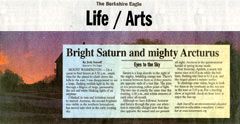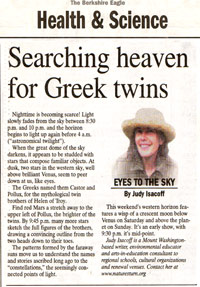Writer Judy Isacoff: Creative Non-Fiction

Columnist: Eyes to the Sky in The Berkshire Eagle
SELECTED COLUMNS
The Broadsheet •
The Broadsheet Daily •
The Berkshire Eagle •
Other Selections

"Eyes to the Sky" The Berkshire Eagle in print & online
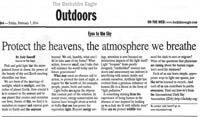
click to read
The Berkshire Eagle, February 7, 2014
Eyes to the Sky
Protect the heavens, the atmosphere we breathe
by Judy Isacoff © 2014

Just want to drop you a note to let you know
how much I enjoy your "Eyes to the Sky" column
in the Berkshire Eagle. I am 69 going on 10 and
still enjoy learning. You make it fun in your column.
-- Carol Ann
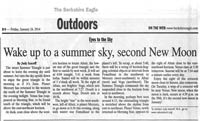
click to read
The Berkshire Eagle, January 24, 2014
Eyes to the Sky
Wake up to a summer sky, second New Moon
by Judy Isacoff © 2014

I just ADORE your writing! It's beautiful - so beautiful.
You're such a teller of nature's tales...I love reading it.
Maybe a book...maybe a daily book....that's what I'm a-thinking!
-- Connie Barron, Singer and Actress
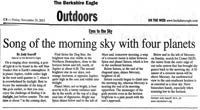
click to read
The Berkshire Eagle, November 29, 2013
Eyes to the Sky
Song of the morning sky with four planets
by Judy Isacoff © 2013
The Berkshire Eagle, Aug 7, 2011
Eyes to the Sky
McDonald's skies: awe-inspiring observatories, astronomers
by Judy Isacoff © 2011
I've just returned from the home of "Star Date", the popular spot aired each day on WAMC (FM 105.1 or 90.3), our local National Public Radio station. The informative series originates from the McDonald Observatory of the University of Texas at Austin. McDonald is known to the international community of astronomers as one of the great observatories of the world. Its Frank N. Bash Visitors Center is a destination for individuals, families, educators and students.
Sited west of Austin in Fort Davis, Texas, the location, at an elevation of 6,791', offers the darkest, clearest skies of any major observatory in the continental U.S.A. The view of three magnificent and several small white or silver observatories on the green mountaintops stirs a sense of awe. This place is dedicated to the study of the heavens!
The domes, that resemble (on a grand scale) the disappearing grain silos of New England, seen closed to the sky in daytime, convey tremendous expectation. There's a raised seal, like an eyelid, that will slide open to the cosmos at nightfall to reveal the telescope. Astronomers then spend the entire night pointing the telescope at distant objects -- planets, stars, nebulae, or galaxies -- to collect their light for study.
It's a competitive process for an astronomer to reserve precious time for research on one of the great telescopes at McDonald. I enjoyed the team that is searching for solar systems like our own around stars nearing the end of their lives. They do not look through the eyepiece of the telescope, rather, instruments record and store the data for later analysis.
Full moon coincides with the Perseid meteor shower at week's end, so only the brightest shooting stars will be visible. Full moon rises Saturday at 7:38 p.m. Look for meteors late at night Friday and Saturday.
The Berkshire Eagle, APRIL 10, 2011
Eyes to the Sky
Bright Saturn and mighty Arcturus
by Judy Isacoff © 2011
On a quest to find Saturn at 8:20 p.m., ample time for the planet to climb above the hills to the east, I was disappointed to see a large, flashing reddish light in the sky through a filigree of twigs, presumably the red and white blinking lights of an airplane. I blinked in turn and irritation turned to marvel... read more (pdf)
The Berkshire Eagle, May 15, 2011
Eyes to the Sky
Corvus the crow flies with the moon tonight
by Judy Isacoff © 2011
Corvus the crow, a graceful, minimalist constellation, soars above the southern horizon as night falls all month. Four stars convincingly outline the head, wing tips and tail of a bird seen flying up from the horizon.
Corvus, Latin for raven or crow, is easy to recognize on the right side of the gibbous moon tonight from about 8:45 p.m. until midnight. The moon then climbs to the upper left of the constellation, which sets in the southwest at 1:30 a.m.
Basically a quadrilateral, Corvus has been perceived as a bird image since the ancient Greeks and illustrates at least two classic myths. In Arabia it was designated a tent and has been a square sail to sailors. It looks very much like a kite, too.
The bright star Spica is always above and to the left of the raven. Tonight a beautiful celestial foursome is composed of the moon, Spica, Saturn and Porrima ascending in that order, in a diagonal line, from left to right. Planet Saturn, with the close companion star, Porrima, can be recognized at the top of the line up.
See Corvus to the right of this array tomorrow and Tuesday. Full moon rises in the southeast at 8:51 p.m. Tuesday.
The Berkshire Eagle, May 8, 2011
Eyes to the Sky
Jupiter's return: planetary pile-up at dawn
by Judy Isacoff © 2011
Jupiter has returned to view in the morning sky. Scarcely two months ago the brilliant planet followed the sun down while this month Jupiter joins Venus rising in the east in the morning twilight, followed by the sun.
A rare planetary pile-up is occurring just before sunrise all month, with perhaps the best naked eye viewing this week between 5:15 a.m. and 5:35 a.m. Timing is of the essence, as well as choosing a vantage point with a clear view of the eastern horizon. Our ability to see the planets is limited due to their rising in the east just before the sun rises in the northeast spreading daylight over our window into the cosmos.
Jupiter is to the lower left of brighter Venus tomorrow morning. They are side-by-side on Tuesday and nearer to each other on Wednesday. It takes patience, ease and focus to locate faint little Mercury to the lower right of Venus. Our solar system's smallest planet may be seen about as far to the lower right of Venus as Jupiter's proximity to Venus on the 9th and 10th.
Mars is closest to the horizon to the lower left of Jupiter. Although it is dimmed by the glare of the rising sun, it might be seen with the aid of binoculars or a scope.
Sunrise is at 5:40 a.m. tomorrow and 5:34 a.m. next Saturday. Venus and Jupiter are so bright that once you have spotted them about twenty minutes before sunup they are visible in the sunrise glare.
The Berkshire Eagle, MAY 24, 2010
Eyes to the Sky
Searching Heaven for Greek twins
by Judy Isacoff © 2010
Nighttime is becoming scarce! Light slowly fades from the sky between 8:30 p.m. and 10 p.m. and the horizon begins to light up again before 4 a.m. ("astronomical twilight")...read more (pdf)
The Berkshire Eagle, May 17, 2010
Eyes to the Sky
Planets at Edges of A Lion in the Sky
by Judy Isacoff © 2010
The constellation Leo the Lion is outstanding for its convincing shape and, therefore, how easy it is to recognize in the sky. Look high overhead toward the south around 9:30 p.m., and further to the west until 1:30 a.m. A prominent curve created by five stars is clearly the head and mane of a lion. A nearby sixth, the brightest of these stars, blue-white Regulus, is Leo's heart. Together the points of light may conjure up a backward question mark or a sickle.
Although not as impressive as the head, but very charming, the body of the lion stretches to the east where the tip of the tail is marked by Denebola, the furthest star of a vivid triangle. Below Denebola is the planet Saturn.
From Saturn, look back to Regulus and continue in a straight line to locate rosy-colored Mars, seemingly under the lion's nose. Mars, Regulus and Saturn are lined up and all are visible at dusk, before most of the stars of Leo appear.
Be sure to see the waxing moon form a moving threesome with Mars and Regulus from twilight until midnight on Wednesday and until 1:30 a.m. at week's end.
The Berkshire Eagle, May 31, 2010
Eyes to the Sky
Live 'stars' come down from heaven
by Judy Isacoff © 2010
Heaven and earth seem to meet as the month of May rolls into June. When raising our eyes to the sky at twilight, fireflies tease us, as if the stars have come down to greet us. This week, find a meadow to gaze over where a troupe of fireflies dances to the loud music of frog song. The lightning bugs even offer a few slow, shooting star-like sightings.
Continuing to lift our gaze around 9:30 p.m., dazzling Venus commands our view to the West. Straight up from Venus see the Big Dipper overhead. One of the most vivid constellations, four stars compose the rectangular bowl from which three stars curve, sketching the handle of the ladle.
The arch of the handle leads us to the third brightest star visible from Earth, yellow-orange Arcturus: "arc to Arcturus". Then "sprint to (bright) Spica" by continuing the curve to the south a somewhat greater distance than the stretch from the Big Dipper to Arcturus.
The Big Dipper is visible all night, though progressively lower in the sky. Arcturus sets just before dawn.
see Sampler for Families







